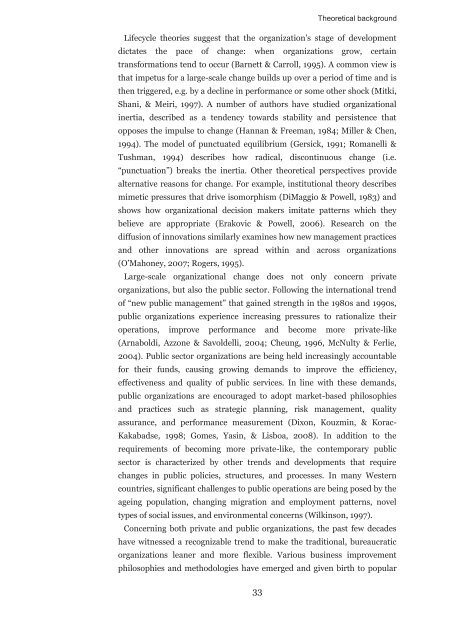Boundary activities and readiness for ... - Projekti-Instituutti
Boundary activities and readiness for ... - Projekti-Instituutti
Boundary activities and readiness for ... - Projekti-Instituutti
Create successful ePaper yourself
Turn your PDF publications into a flip-book with our unique Google optimized e-Paper software.
Theoretical background<br />
Lifecycle theories suggest that the organization’s stage of development<br />
dictates the pace of change: when organizations grow, certain<br />
trans<strong>for</strong>mations tend to occur (Barnett & Carroll, 1995). A common view is<br />
that impetus <strong>for</strong> a large-scale change builds up over a period of time <strong>and</strong> is<br />
then triggered, e.g. by a decline in per<strong>for</strong>mance or some other shock (Mitki,<br />
Shani, & Meiri, 1997). A number of authors have studied organizational<br />
inertia, described as a tendency towards stability <strong>and</strong> persistence that<br />
opposes the impulse to change (Hannan & Freeman, 1984; Miller & Chen,<br />
1994). The model of punctuated equilibrium (Gersick, 1991; Romanelli &<br />
Tushman, 1994) describes how radical, discontinuous change (i.e.<br />
“punctuation”) breaks the inertia. Other theoretical perspectives provide<br />
alternative reasons <strong>for</strong> change. For example, institutional theory describes<br />
mimetic pressures that drive isomorphism (DiMaggio & Powell, 1983) <strong>and</strong><br />
shows how organizational decision makers imitate patterns which they<br />
believe are appropriate (Erakovic & Powell, 2006). Research on the<br />
diffusion of innovations similarly examines how new management practices<br />
<strong>and</strong> other innovations are spread within <strong>and</strong> across organizations<br />
(O’Mahoney, 2007; Rogers, 1995).<br />
Large-scale organizational change does not only concern private<br />
organizations, but also the public sector. Following the international trend<br />
of “new public management” that gained strength in the 1980s <strong>and</strong> 1990s,<br />
public organizations experience increasing pressures to rationalize their<br />
operations, improve per<strong>for</strong>mance <strong>and</strong> become more private-like<br />
(Arnaboldi, Azzone & Savoldelli, 2004; Cheung, 1996, McNulty & Ferlie,<br />
2004). Public sector organizations are being held increasingly accountable<br />
<strong>for</strong> their funds, causing growing dem<strong>and</strong>s to improve the efficiency,<br />
effectiveness <strong>and</strong> quality of public services. In line with these dem<strong>and</strong>s,<br />
public organizations are encouraged to adopt market-based philosophies<br />
<strong>and</strong> practices such as strategic planning, risk management, quality<br />
assurance, <strong>and</strong> per<strong>for</strong>mance measurement (Dixon, Kouzmin, & Korac-<br />
Kakabadse, 1998; Gomes, Yasin, & Lisboa, 2008). In addition to the<br />
requirements of becoming more private-like, the contemporary public<br />
sector is characterized by other trends <strong>and</strong> developments that require<br />
changes in public policies, structures, <strong>and</strong> processes. In many Western<br />
countries, significant challenges to public operations are being posed by the<br />
ageing population, changing migration <strong>and</strong> employment patterns, novel<br />
types of social issues, <strong>and</strong> environmental concerns (Wilkinson, 1997).<br />
Concerning both private <strong>and</strong> public organizations, the past few decades<br />
have witnessed a recognizable trend to make the traditional, bureaucratic<br />
organizations leaner <strong>and</strong> more flexible. Various business improvement<br />
philosophies <strong>and</strong> methodologies have emerged <strong>and</strong> given birth to popular<br />
33









